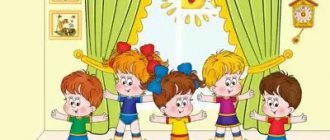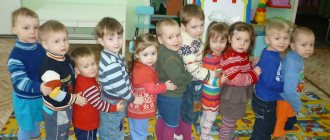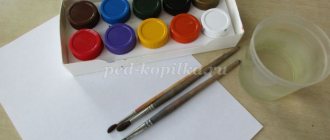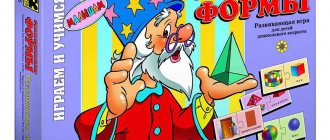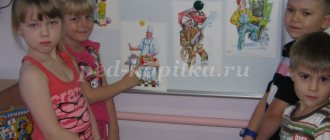Children in kindergarten engage in a wide variety of games and exercises, including finger exercises. Some adults consider these activities to be fun, entertainment, but scientists have long proven that the development of fine motor skills of the hands is directly related to the intellectual and speech development of the child. That is why preschool institutions pay great attention to finger gymnastics and games for fingers and palms.
- 2 Principles of organizing gymnastics for fingers and palms
- 3 Preparation and performance of finger gymnastics
3.1 Table: chestnut massage accompanied by a text with a fairy-tale plot “The Adventures of a Chestnut Boy”
- 3.2 Rules for finger gymnastics
- 3.3 Table: card index of finger gymnastics classes in the middle group of preschool educational institutions
- 3.4 Table: examples of poetic works for finger games in the middle group
- 3.5 Photo gallery: attribute templates for games to develop fine motor skills
- 4.1 Table: summary of a lesson on the development of fine motor skills in the middle group “Journey to a Fairy Tale”, compiled by E. D. Gladchenko
The importance of finger exercises for the development of preschool children
Finger games and finger gymnastics are a type of children's motor activity, the main goals of which are:
- development of fine motor skills of the hand, palm and fingers;
- improvement and enrichment of tactile sensations;
- development of skills to manipulate small objects and perform actions with them.
Unlike games, finger gymnastics has a clearer, fixed structure, involves performing actions in a certain order, according to the model shown by the teacher, and includes elements of self-massage. But since finger games are exciting, dynamic and have a great influence on the development of the emotional sphere of preschoolers, they can also be used during organized educational activities as a type of light gymnastics for the palms and fingers.
Why are exercises for fingers and palms so useful in preschool age? The well-known phrase by V. A. Sukhomlinsky “The child’s mind is at the tips of his fingers” reveals one of the main goals of these exercises: to promote the development of intelligence, cognitive activity, and curiosity of the baby.
Unlike adults, for children to get a complete understanding of a subject, it is not enough to see it. They need to touch it, try it out, find out whether it is hard or soft, flexible or not, what play actions can be performed with it, whether it makes sounds, whether it is pleasant to the touch. All information received is transmitted from the fingers to the brain, stimulating its increased work. By doing finger gymnastics with the baby, we develop his hands as a tool for active exploration of the world around him.
Tactile sensations received by children with the help of their hands give them no less ideas about the world around them than vision
However, in addition to such an important task, finger gymnastics also pursues a number of other, no less significant:
- Speech development. Teachers and psychologists note that the more a child does exercises to develop fine motor skills, the faster he begins to speak, using complete sentences in his speech, and more actively includes adjectives, verbs, and words to describe the emotional state of himself and those around him.
- Health promotion. There are biologically active points on the palms and fingers, influencing which increases the child’s immunity and resistance to various diseases.
- Improving thinking processes (memory, attention). This is facilitated by the motor exercises themselves, and by the poetic or prose texts that accompany gymnastics.
They note the positive impact of finger exercises on the psyche of children. It calms those who are hyperactive and excitable, and allows kids who are too shy and insecure to open up, feel freer, and more relaxed in a team.
If finger gymnastics brings joy, then it is doubly useful: both for mental development and for the formation of the emotional sphere of the child.
Pros of finger warm-up
Fun with fingers is an exciting and fun activity that can keep your child occupied for a long time anywhere - from a queue at the clinic to a car trip. They do not require any costs, bring a lot of fun and develop many new qualities and skills in children:
- Game movements accompanied by words train memory. Do you remember how, when he was very small, the baby repeated individual words from the text of the nursery rhyme, focusing on its rhythm? At 4-5 years old, children are able to quickly memorize a fairly long poem precisely as an association with the game;
- Tactile perception training develops the sense of touch. The child is aware of the physical qualities of objects - rough, smooth, cool, warm, heavy, soft, etc.;
- Stimulation of fine motor skills at the age of 4-5 years prepares the baby’s hand for writing, simultaneously awakening speech activity. Preschoolers who regularly do finger gymnastics draw more accurately and subtly, perform complex applications, and most importantly, they can come up with a detailed plot for such works themselves;
- Throughout the entire lesson, the child watches the actions of the adult, trying to remember their sequence - this is how the ability to concentrate and perseverance is formed;
- As a result of the lessons, the speech of 4-5 year old children becomes more coherent, acquires intonation variety and an even pace. Conversational topics gain variety, the baby learns to reason, building logical chains;
- Finger gymnastics can develop an ear for music if the poem is recited, or even better, to simple music;
- A cheerful game between 4-5 year old children and a teacher or parent helps to strengthen psycho-emotional contact, because positive impressions from gymnastics will first of all be associated with the personality of the adult who discovered a new entertainment for them.
If you look at finger gymnastics from a physiological point of view, good coordination of movements has great practical benefits - kids quickly learn to fasten buttons on their own, tie shoelaces, and sculpt from plasticine.
Principles of organizing gymnastics for fingers and palms
When conducting finger gymnastics in the middle group of a kindergarten, the teacher should rely both on the general principles used in organizing the activities of pupils, and on the mental and physiological characteristics of children in the fifth year of life.
The organization of gymnastics is based on the principles:
- Systematic and gradual. Gymnastics classes are held regularly, with gradual complication and mandatory repetition of exercises.
- Comfort and voluntariness. Classes should bring children pleasure and joy, and participation in them is always free, at the request of the children. In order for children to perceive gymnastics with interest and actively participate in it, the teacher uses various techniques: artistic expression; attracting a game character; colorful paraphernalia (bright balls, caps with “portraits” of animals, fairy-tale characters.
- Availability and feasibility. All materials (poems, nursery rhymes, illustrations, pictures) that the teacher uses must be appropriate for the age of the children, be familiar to them, and understandable, so as not to cause hesitation or reduce the dynamism of the game.
- Individual approach. Children of the middle group, unlike the younger and nursery groups, no longer need the teacher to teach them exercises every step of the way, taking the child’s hand in his own and manipulating his fingers. Four-year-olds can easily repeat a movement that is shown to them 1-2 times. But the teacher must keep all the children in sight, and if some of the exercises cause difficulties for some of them, or the children perform them incorrectly, work should be done with such children to reinforce the correct position of the fingers during the exercise. This will help kids in other activities (teach children how to properly hold a spoon, pencil, and manipulate objects in games).
Compliance with these principles will help the teacher carry out this type of activity with the greatest benefit for the kids, in a fun way and at the right pace.
When performing gymnastics for fingers in the middle group, it is necessary to pay attention to the synchronization of movements of both hands, whereas a year earlier children could perform movements (rolling a ball on their palm, “walking” with their fingers along the path) with one hand. To do this, children are taught to perform the movement first with one (right) hand, then with the other, and then with both hands together. Gymnastics includes as many exercises as possible on the interaction of hands: tapping, stroking, patting, connecting fingers in pairs. Actions must be performed either simultaneously, or with both hands alternately, for which sometimes the text must be repeated twice. You cannot limit yourself to performing exercises with one hand.
In the middle group, the teacher is given a new task: to teach children to coordinate the movements of both hands
Example of a lesson summary
Below is a summary of a finger gymnastics lesson in the middle group “Morning Greeting”.
Goals:
- development of fine motor skills through finger exercises;
- improving speech skills; study of body parts;
- development of thinking, imagination, coordination of movements;
- creating a positive mood for the whole day.
The teacher greets the children. He asks if they slept well, what their mood is: Did our fingers wake up? Let's wake them up!
Morning has come, the sun has risen!
Get up, big guy! (with the fingers of one hand we bend and stretch the fingers of the other, clenched into a fist - starting with the thumb)
Get up, pointer! (bend the index finger)
Get up, middle! (bend and stretch the middle finger)
Get up, little orphan! (we work with the ring finger)
Get up, little one! (little finger)
We repeat the exercises for the other hand.
Educator: fingers woke up! What about eyes, ears, legs?
Wake up, my little eyes! (imitation - twist the binoculars, focus)
Wake up, my ears! (stroked, kneaded with fingers, rubbed the lobe with the index and thumb)
Wake up, my hands! (patted from shoulder to hand, clapped hands)
Wake up, my legs! (patted, stomped)
Wake up, head! (pat yourself on the head)
Now I'm all awake! (reached up, clapped and waved their palms in greeting)
Preparation and performance of finger gymnastics
To effectively conduct the exercises, the teacher needs to consider the following points:
- Equipment, attributes. Currently, attributes for finger gymnastics and games can be found on the Internet by printing and cutting out caps, mini-masks of animals and other characters. For strength and better preservation, paper attributes should be covered with tape or transparent self-adhesive film. Embossed and “spiky” massage balls are also prepared in advance and children are first introduced to them so that during gymnastics the children are not distracted by exploring and looking at them. Natural materials are also widely used: chestnuts, walnuts.
- Scientific information. Since gymnastics for fingers and palms is carried out with elements of self-massage and acupressure, the teacher needs to get advice from a preschool nurse to find out how to carry it out correctly. If acupressure and finger exercises are included in the system of hardening procedures of a preschool institution, diagrams of their implementation indicating the sequence of exercises and points of influence for all age groups are stored in the nurse’s office.
- The text that accompanies the gymnastics. It can be both in poetry and in prose. The teacher can come up with the text independently or use the work of colleagues, recommendations of a methodologist, or a nurse. If gymnastics (massage) are presented in the form of a list of exercises without text, it is quite acceptable to accompany them not with poetry, but with prose in accordance with the content of the gymnastics. The text must be pronounced slowly, expressively, and emotionally, so that the children have time to complete the exercises and are interested in what they are doing. Gymnastics or massage will be of particular interest to children if a creative teacher comes up with a short fairy tale for them.
Table: massage with chestnuts accompanied by a text with a fairy-tale plot “The Adventures of a Chestnut Boy”
| Exercise | Teacher's words | Actions Performed |
| 1. Warming up your palms and fingers. | In one park there lived a little chestnut tree. Here it is. He found out that in our kindergarten the children love to massage with balls, and he wanted to make friends with the children, because the chestnut itself looked like a ball. | Children alternately stroke, squeeze and unclench the fingers of both hands, warming them up. |
| 2. Clenching and unclenching your fingers. | The chestnut rolled into the kindergarten, into our group, and immediately fell into the warm and kind hands of the children. | Children take chestnuts from the plates, squeeze them in their palms, open them slightly, and show the chestnuts to each other. |
| 3. Rolling a chestnut across the palm. | The chestnut wanted to play with the kids, roll on his palms like a bun. At first he rolled on one palm... then on the other. | Children place the chestnut on their open left palm, roll it with their right hand, then vice versa. |
| 4. Massage of elbows and shoulders. | The chestnut boy wanted to travel, so he first ran to his elbow and rode there. Then to the shoulder, and there he rode. And he returned to his fingers. | Children pinch the chestnut with the fingers of their right hand, move it from the wrist to the elbow of the left hand, make 3-4 circular movements, lift the chestnut to the shoulder, roll it over the shoulder, then return it to the palm. The same with the other hand. |
| 5. Free movements of the arms above the head. | The chestnut boy felt happy and wanted to dance. First in one handle, then in the other. | Children make “lanterns” over their heads, holding the chestnut in two hands alternately. |
| 6. Relaxation exercise. | The little chestnut was tired and wanted to rest. And our guys’ hands are also resting. | Children place chestnuts on plates and make “shaking” movements with their hands. |
| Notes. | The text may vary depending on the exercises performed. The teacher must ensure that children change hands and chestnuts in them on time. Those who cannot roll chestnuts along the shoulder and elbow, move them by holding them with their fingers. | |
Chestnut, walnut, hex pencil - all these items, when used skillfully, will help children develop hand motor skills
Rules for finger gymnastics
Children are introduced to new gymnastics or finger massage in the following sequence:
- The teacher draws attention to the toy, the illustration, which corresponds to the theme of gymnastics, and informs them that they will get acquainted with new exercises. You can involve a game character (Dunno, Matryoshka) and invite children to learn gymnastics with them.
- The teacher leisurely reads a poetic text or a nursery rhyme, consistently demonstrating the exercises to the children.
- Children perform gymnastics, the teacher reads the text and at the same time shows the movements again.
- The teacher sums up, praises the children, draws their attention to how dexterous and skillful their fingers will become if they always do the exercises so diligently.
If gymnastics is already familiar to children, the teacher should encourage their independence, support the desire to partially pronounce poetic texts, and recall the sequence of exercises. In this type of activity there is also a place for creativity and imagination: children can, under the guidance of a teacher, make some attributes, finger caps, and come up with new movements that reveal the character of a particular hero. After completing the exercises, children can play with the characters, freely develop the plot, and perform several simple actions (the characters walk, dance, meet, communicate).
Bright, colorful and accessible attributes are a sure guarantee of preschoolers’ high interest in finger exercises
To instill in children a love of independent finger games, the teacher must place equipment for them in a visible place and provide free access to it. You can also give children chestnuts, walnuts, small balls, large beads on a tightly tied braid for independent practice. But peas, beans and other small materials for independent activities are not given to children, since these items can pose a health hazard. The children work with them under the strict supervision of an adult.
When performing gymnastics and self-massage, one should not forget the important rules:
- Children need to be adjusted, organized, switching their attention from other activities.
- The exercises always begin by warming up the hands, palms, and light stroking until a feeling of warmth appears.
- The exercises are performed 3–5 times with both hands or alternately with the right and left.
- It is necessary to monitor the correct position of the hand and fingers, and the precise execution of movements.
- The teacher performs all exercises together with the children, adjusting to the pace of the group. Individual work is carried out with those who do not have time.
- During gymnastics, children should be relaxed and in a good mood. This is facilitated by the soft, friendly tone of the teacher. It is recommended to use quiet, calm music that does not interfere with the perception of words.
- A separate lesson of one finger gymnastics lasts no more than 5–6 minutes, otherwise children will get bored and lose interest in it. If the teacher introduces gymnastics into educational activities (EAC), then you can take 2-3 complexes and distribute them evenly during the lesson. In this case, gymnastics is reduced to 2-3 minutes by eliminating the introductory and final parts. More than 3 different types of gymnastics in the middle group can be used in a thematic lesson about finger games or in an open lesson, the purpose of which is to introduce colleagues to this type of work.
- The learned complexes are repeated throughout the school year, gradually becoming more complex (increasing the number of repetitions and accuracy of movements). At the same time, new, more complex complexes are being added.
Forms of gymnastics:
- Frontal (with all children in the group). It is effective during learning, during visual arts classes, and during walks in the fresh air.
- Subgroup. It is carried out with part of the group (5-8 people) during the time allocated for free play indoors at the request of the children. Children who are not involved in gymnastics are involved in other activities under the supervision of an assistant teacher or the teacher himself (drawing, playing with construction sets, toys, looking at books, illustrative material).
- Individual. Exercises are performed by 1–2 children under the supervision of a teacher. They work individually most often with children who experience difficulties with frontal and subgroup teaching.
With the whole group of children, gymnastics is carried out more often in class, and with a subgroup - in their free time.
Table: card index of finger gymnastics classes in the middle group of preschool educational institutions
| Topic and tasks | Content |
"Tom Thumb."
| Finger gymnastics move. Warm up fingers: flexion and extension. You can use rubber toys with squeaks for this exercise. Exercise 1. Palms on the table (on the count of “one-two”, fingers apart - together.) Exercise 2. Palm – fist – edge (on the count “one, two, three”). Exercise 3. Fingers shake hands (at the count of “one-two-three-four-five” the fingers of both hands are connected: thumb with thumb, index with index, etc.) Exercise 4. Little man (index and middle fingers of the right, and then left hands run across the table). Exercise 5. Children run a race (movements are the same as in the fourth exercise, but perform both hands at the same time). |
"Goat, hares and squirrel."
| Progress of finger gymnastics Warm up fingers: flexion and extension. You can use rubber toys with squeaks for this exercise. Exercise 1. Goat (extend the index finger and little finger of the right hand, then the left hand). Exercise 2. Little goats (the same exercise, but performed simultaneously with the fingers of both hands). Exercise 3. Glasses (form two circles from the thumb and index fingers of both hands, connect them). Exercise 4. Hares (extend the index and middle fingers upward, connect the thumb, little and ring fingers). Exercise 5. Trees (raise both hands with palms facing you, fingers spread wide). |
"Kitty".
| Progress of finger gymnastics Warm up fingers: flexion and extension. You can use rubber toys with squeaks for this exercise. Exercise 1. Flag (pull your thumb up, connect the rest together). Exercise 2. Birds (alternately the thumb is connected to the rest). Exercise 3. Nest (connect both hands in the form of a bowl, clench your fingers tightly). Exercise 4. Flower (the same, but the fingers are separated). Exercise 5. Plant roots (press the roots - hands with the backs of each other, lower your fingers down). |
"Friends". Development of skills:
| Progress of finger gymnastics Warm up fingers: flexion and extension. You can use rubber toys with squeaks for this exercise. Exercise 1. Bee (rotate the index finger of the right and then the left hand around). Exercise 2. Bees (the same exercise is performed with both hands). Exercise 3. Boat (point the ends of your fingers forward, press your hands with your palms to each other, slightly opening them). Exercise 4. Sun rays (cross your fingers, raise your hands up, spread your fingers). Exercise 5. Passengers on the bus (crossed fingers pointing down, backs of hands up, thumbs up). |
In addition to finger gymnastics, the classes widely use games for fingers and palms on a wide range of topics, often combined with the theme of the main lesson. High activity and interest of children in this type of activity is ensured by funny, easy-to-remember poems that accompany every movement.
Table: examples of poetic works for finger games in the middle group
| Mushrooms. Red, red fly agaric - (We connect our fingertips - we draw a mushroom hat). White speckled pattern. (One hand is a “mushroom cap”; with the index finger of the other hand we show “speckles”). | Cloth. I'll put on boots, (Point to legs, torso, head). Jacket and hat. And on each hand (One hand with straightened fingers up, the other runs along the little finger and the edge of the palm, showing the direction of putting on gloves). I'll pull on the glove. (Change hands). |
| Shoes. We put shoes on our feet to run on the track. (They “walk” on the table with two fingers.) Repeat the words after me: (Clench and unclench your fingers). Leg - one, leg - two! (Place two fingers on the table and raise one at a time.) They buy in the store (Clench and unclench their fingers). And Dad, Mom, Brother and I put them on their feet - (Bend their fingers). The whole family loves shoes. (“They walk” their fingers on the table). | Dishes. From the plates, as one, (Palms together in front of you “plate”). We eat soup with spoons. (Rotational movements of the hand with an imaginary spoon). We eat cutlets with a fork (the index and middle fingers are straightened, the thumb holds the ring and little fingers - “hold the fork”). The knife cuts our omelettes. (“Cut” with a straight palm back and forth). |
| Food. Knead the flour into the dough (Clench and unclench your fingers). And we sculpted from the dough (Clap with palms, “sculpt”). Pies and buns, (Alternately extend the fingers, starting with the little finger). Butter cheesecakes, buns and rolls - (Both palms are turned up). We will bake everything in the oven. Delicious! (Stroke bellies). | Winter. Snow falls on the houses (we spread our arms to the sides, palms down). Streets and rooftops. (Hands like a house). Winter is quietly coming towards us, (Finger to lips. “Let’s go” with the index and middle fingers of one hand). We can’t hear her... (Hand behind ear). |
| Furniture. We slept on the crib, (Hands under cheeks). Things have already been put away in the closet. (We move our hands freely - “putting things away”). We sat on a chair (we cover the fist of the other with the palm of one hand). And we ate at the table. (Rotational movements of the hand with an imaginary spoon). | Transport. Cars are walking along the highway (Turn an imaginary steering wheel). Tires are rolling on the asphalt. (Elbows are pressed to the body, palms move parallel to each other). Don't run along the road (they shook a finger). I'll tell you: "Beep." (The hand is clenched into a fist, the thumb is straightened - “signal”). |
| Quote from: https://infourok.ru/kartoteka-palchikovoy-gimnastiki-dlya-sredney-gruppi-1716259.html | |
Photo gallery: attribute templates for games to develop fine motor skills
Character figures can be put on fingers like caps Figures with slots for “legs” allow children to “drive” their character along a table or other flat surface
No less popular are figurines that are worn according to the thimble principle.
Games about household chores and responsibilities
I 'm helping my mother
Our son washed the dishes. I washed the mugs, bowls, and knife. He wiped the forks and plates - He ran off to play with the burners. (Perform imitating movements according to the text)
Mom's helpers
(Show movements in accordance with the text)
We are mother's helpers, we will help her. Let's wash all the dishes and tidy up the bed. We'll wash the laundry, hang it up to dry, and in the evening we can all drink tea together!
Washing the dishes
(first hit your fists against each other, perform circular movements with your palm on your palm, then bend your fingers while counting objects)
One, two, three, four, (hit with fists) We washed all the dishes: Forks, bowls, ladles, frying pans and spoons. We washed all the dishes, We just broke the cup, The knife also broke, The salt shaker had a side left. The kettle was broken a little, together they helped mom.
Activities using finger games and gymnastics
Games and exercises for the development of fine motor skills can be used in organized educational activities in all educational areas. Particularly successful would be the choice of a game or gymnastics, the topic of which coincides with the topic of the lesson. In this way, children will consolidate their acquired knowledge.
The total duration of the lesson should not exceed the limits recommended by sanitary standards:
- 20 minutes. for subject classes;
- 25 min. for integrated and complex.
The structure and time frame of the lesson are also preserved:
- Introductory part (organization of children, greeting, interesting moment). Up to 2 min.
- The main part (games, conversations, exercises, looking at illustrations, reading works, communicating new things or consolidating learned material). 16–20 min.
- The final part (summarizing, encouragement, analysis of the lesson). Up to 2 min.


